Do you want to grow your brand, gain a global following, and go viral? The secret to that is social media marketing.
Social media sites like Facebook, Instagram, Twitter, and YouTube have completely changed how we interact, communicate, and obtain information in the modern digital age.
Additionally, these platforms allow businesses to market their goods and services in an engaging, participatory manner.
Social media marketing that works involves more than merely sharing advertisements. It all comes down to providing your audience with engaging material that encourages active engagement.
Understanding their target demographics and producing content, particularly for various platforms, has helped brands like Red Bull, Netflix, and L’Oréal succeed.
Analytics and data are also quite important. Platforms offer comprehensive insights into what truly engages followers and generates meaningful interaction. You may become viral overnight with the correct campaign optimization based on these insights.
Trends also change all the time. Making the most of your efforts requires adapting to recent innovations, such as Instagram Reels or algorithm modifications.
Our social media marketing specialists at BrandLoom have assisted countless companies in using these channels to raise sales, create leads, and build brand recognition.
We’ll provide case studies, insights, and strategic advice to help you maximize the potential of this effective marketing channel.
What is social media marketing?
Simply, social media marketing is increasing website traffic or attention using social media networks.
But did you know that Six Degrees, founded in 1997, was the first known social networking site? Or that over 4.9 billion individuals worldwide regularly use social media?
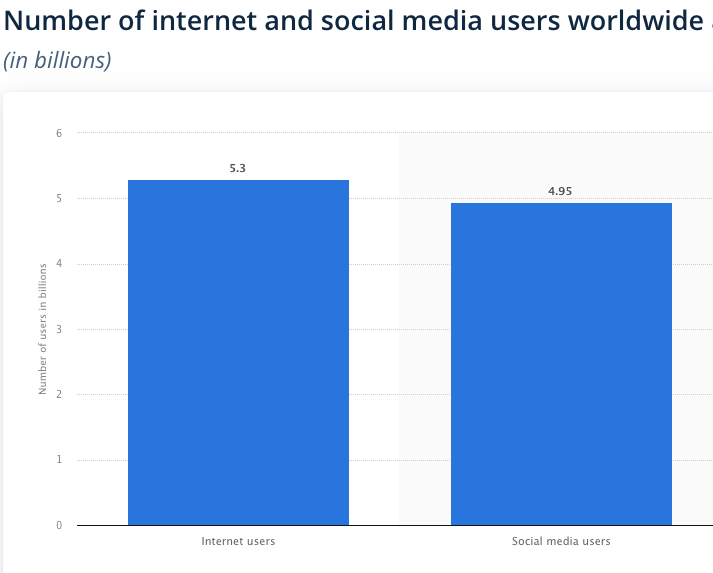
Social media marketing aims to develop content your target audience will engage with and share on platforms like Facebook, Twitter, Instagram, YouTube, and LinkedIn.
With free word-of-mouth advertising, the more shares and interactions your content receives, the broader your reach grows! Wendy’s successful Twitter account is an example, where a single sarcastic message may earn over 50K likes.
These days, businesses try to enhance brand exposure, website traffic, and sales by employing strategies such as utilizing relevant hashtags to join more extensive conversations or placing Facebook advertising to push information in front of interested individuals. The idea is to provide value through entertaining or instructional information.
As such, social media allows for the forming of communities centered on brands.
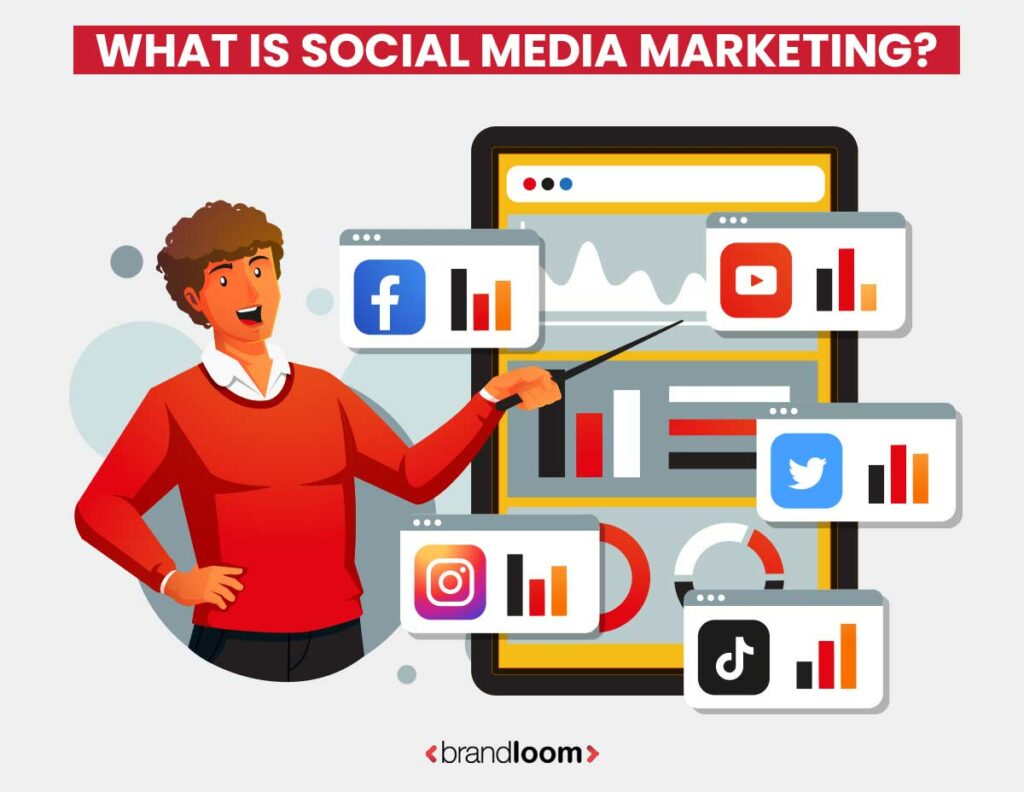
Examples of social media platforms used in marketing
Social media marketing uses a range of venues to reach and engage with consumers. Here are some popular social media channels that brands have used successfully for marketing:
1. Facebook:
With over 2.8 billion monthly active users, Facebook provides diverse advertising and targeting choices. Coca-Cola, for example, has used Facebook effectively to engage with its audience with interactive ads such as the “Share a Coke” campaign, in which users could personalize virtual Coke bottles and share them with friends.
2. Instagram:
Because of its visual appeal, Instagram is a strong medium for marketers to promote items and engage with their target audience. Nike, for example, uses Instagram hashtags like #JustDoIt to highlight inspiring athlete stories, promote new product launches, and communicate with fans.
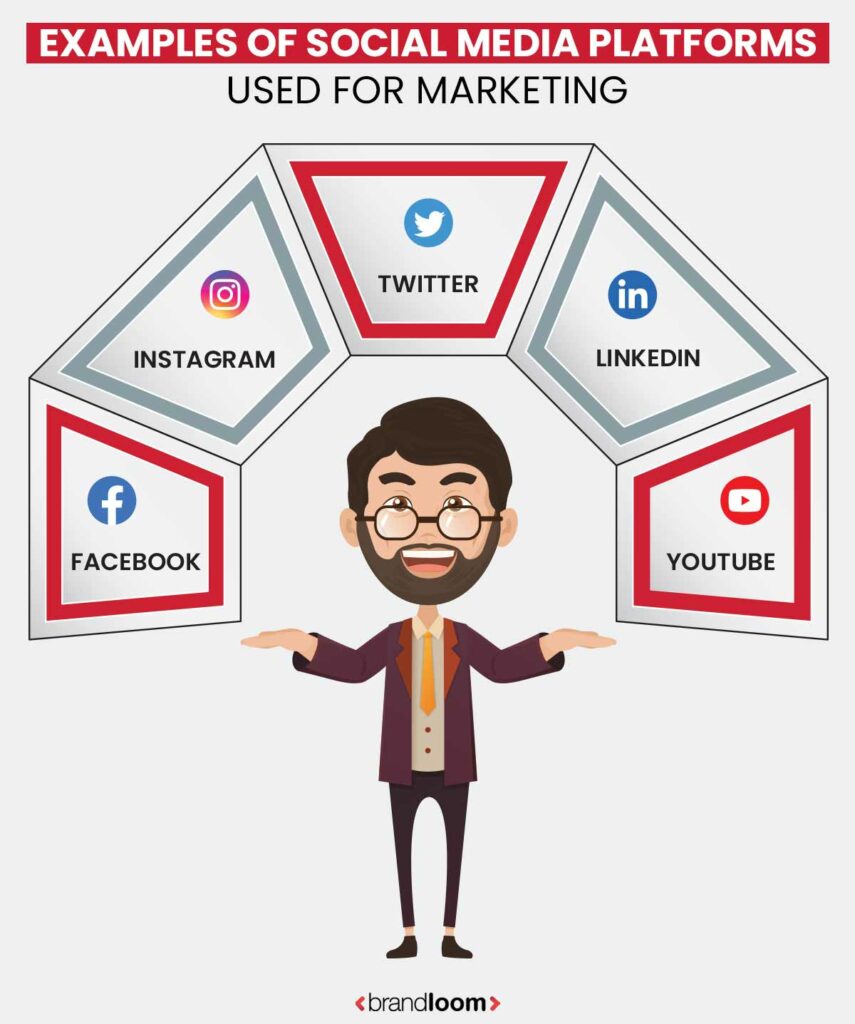
3. Twitter:
Because of its real-time nature, Twitter is an excellent platform for brands to engage in conversations, share information, and give customer support. Wendy’s, a fast-food restaurant, earned popularity for its clever and hilarious responses to customer concerns, resulting in a devoted following and enhanced brand visibility.
4. LinkedIn:
LinkedIn, as a professional networking tool, is useful for B2B marketing and building thought leadership. HubSpot, a marketing software firm, uses LinkedIn to share industry information, educate customers, and interact with experts in their target market.
5. YouTube:
With billions of consumers watching videos every day, YouTube provides a platform for marketers to generate engaging video content. GoPro, a camera maker, has established a large YouTube presence by posting user-generated material that features thrilling adventures and breathtaking visuals recorded with its cameras.
6. Pinterest:
Pinterest is a social networking platform and visual discovery engine that allows users to share and discover new interests by uploading photos or videos to their own or others’ boards and viewing what other users have pinned. Moreover, it has over 400 million monthly active users, and promotes inspiration and idea sharing by allowing users to organize and filter information into groupings known as boards.
7. Reddit:
Reddit is a website for social news gathering, web content ranking, and debate. Registered users publish stuff to the site, such as links, text entries, photos, and videos, which are then rated positively or negatively by other users. This voting method decides the popularity and rank of postings while also assisting in the curation of the site’s various materials.
Members can communicate with certain themes or groups through subreddits. Reddit, which has over 430 million monthly active users, considers itself the internet’s first page since its user-generated content covers everything from current events and politics to entertainment, gaming, and more.
8. Discord:
Discord is a free audio, video, and text chat program for gamers. Moreover, it has comprehensive features targeted at gaming communities allow players to chat over servers both during and outside of games. Topic-based chat channels are available on servers, as well as video calling, direct messaging, and voice chat features. Users may administer communities within each server using intuitive permissions and moderation tools. Discord, which has over 150 million active monthly users, allows gamers worldwide to communicate in real-time.
Importance of Social Media Marketing
Social media marketing is critical in today’s digital landscape, providing several benefits to organizations and individuals. Here are some of the most important reasons why social media marketing is vital:
1. Increased Brand Awareness:
Because social media platforms have a large reach, businesses may showcase their brand to a larger audience. Brands may expand their visibility, reach new prospective consumers, and improve brand recognition by continuously sharing valuable content and engaging with users.
2. Targeted Advertising:
Social media platforms provide enhanced targeting capabilities, allowing businesses to reach out to specific demographics, interests, and behaviors. This precision targeting guarantees that marketing efforts are focused on the most appropriate audience, boosting the likelihood of lead generation and conversion.
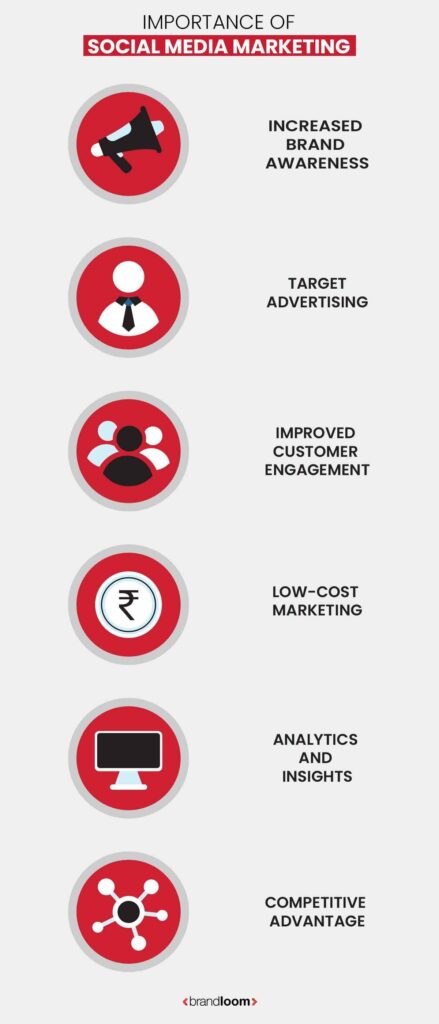
3. Improved Customer Engagement:
Social media allows businesses to communicate directly with customers. Brands can have real-time discussions, reply to inquiries, and provide consumer support, all while building trust and loyalty. Companies can also use active engagement to obtain useful feedback and insights to improve their products or services.
4. Low-Cost Marketing:
Unlike traditional advertising, social media marketing is frequently a lower-cost option. Many social media sites offer low-cost advertising solutions, allowing businesses of all sizes to promote their products and meet their marketing objectives.
5. Analytics and Insights:
Social media networks offer powerful analytics capabilities that provide insights into audience demographics, engagement metrics, and content success. This data enables firms to assess the efficiency of their marketing activities, make data-driven decisions, and improve their strategy.
6. Competitive Advantage:
In today’s competitive industry, having a strong social media presence can provide a competitive advantage to firms. Businesses may position themselves as industry leaders and separate themselves from the competition by actively engaging with their audience, sharing relevant material, and staying current on industry trends.
Five Core Pillars Of Social Media Marketing
1. Content Creation
Produce valuable, shareable, and high-quality content that resonates with your target audience, such as blog posts, videos, and images. The purpose of this content ought to be to inform, captivate, or motivate.
2. Community Building
Community development involves actively participating in pertinent discussions, responding to audience comments and messages, and fostering connections with them. Building a sense of community around your brand is the objective.
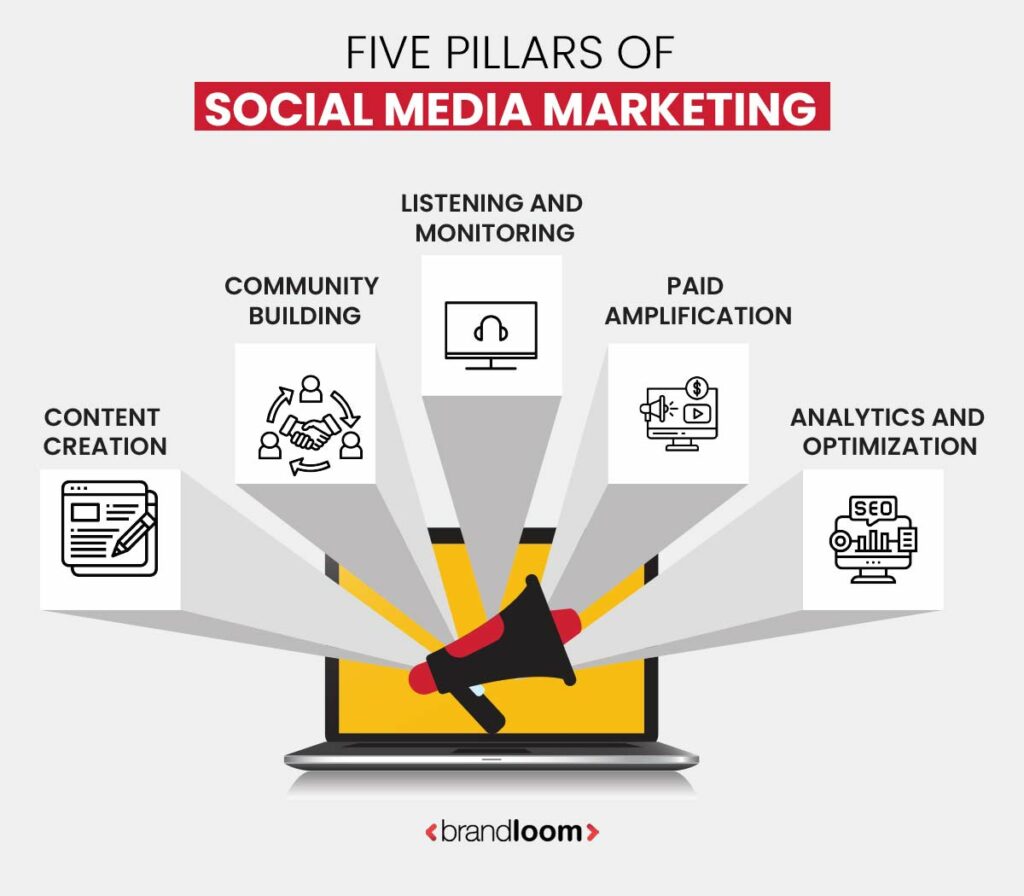
3. Listening and Monitoring
Actively monitoring and listening to conversations that are taking place regarding your brand and industry. This involves establishing alerts, monitoring keywords and hashtags, and utilizing social eavesdropping tools.
4. Paid Amplification
Paid Amplification entails executing paid campaigns, such as social media advertisements, to increase exposure and expose content to new audiences. Setting objectives, targeting specific demographics, and testing advertisements are required.
5. Analytics and Optimization
Analytics and optimization involve monitoring critical performance indicators such as engagement, interactions, conversions, and more. Utilize the information to optimize strategy and content for improved results. Refinement and testing are essential.
How to create a successful social media marketing strategy?
Thorough preparation and execution are necessary for an effective social media marketing strategy. The following are the main areas on which companies should concentrate:
1. Determine who’s your target market
Identifying the intended audience is the first step in creating a successful social media plan. Businesses that understand their audience’s demographics, interests, and behavior patterns may provide content that appeals to them and encourages interaction. Social media companies provide a range of tools and analytics to assist companies in learning demographics, hobbies, and other details about their following.
Depending on your objectives and the location of your target audience, you may choose the best platform.
2. Establish precise targets and goals
Setting clear goals and objectives is required for assessing the efficacy of a social media marketing campaign.
Companies need to decide what they want to accomplish using social media. Do you want to raise awareness of your brand? Produce leads? Increasing sales or website traffic?
Businesses that create SMART (specific, measurable, realistic, relevant, and time-bound) objectives may monitor their success and adjust their approach.
3. Produce and disseminate insightful material
Developing and disseminating quality content is crucial for grabbing followers’ attention and drawing in new clients. Companies should create a content strategy consisting of promotional, educational, and entertaining material that fits their target market and brand message.
Social media networks provide a range of content types, including:
A. Write Content
Written postings continue to be a popular sort of material on social media. On social media, users may express their thoughts, opinions, experiences, knowledge, creative writing, and more through status updates, articles, captions, comments, messages, reviews, tales, and other text formats.
Because of its brevity and accessibility, textual material is one of the most popular ways for people to connect. Written material quickly distributes ideas and enables for self-expression in a portable digital format.
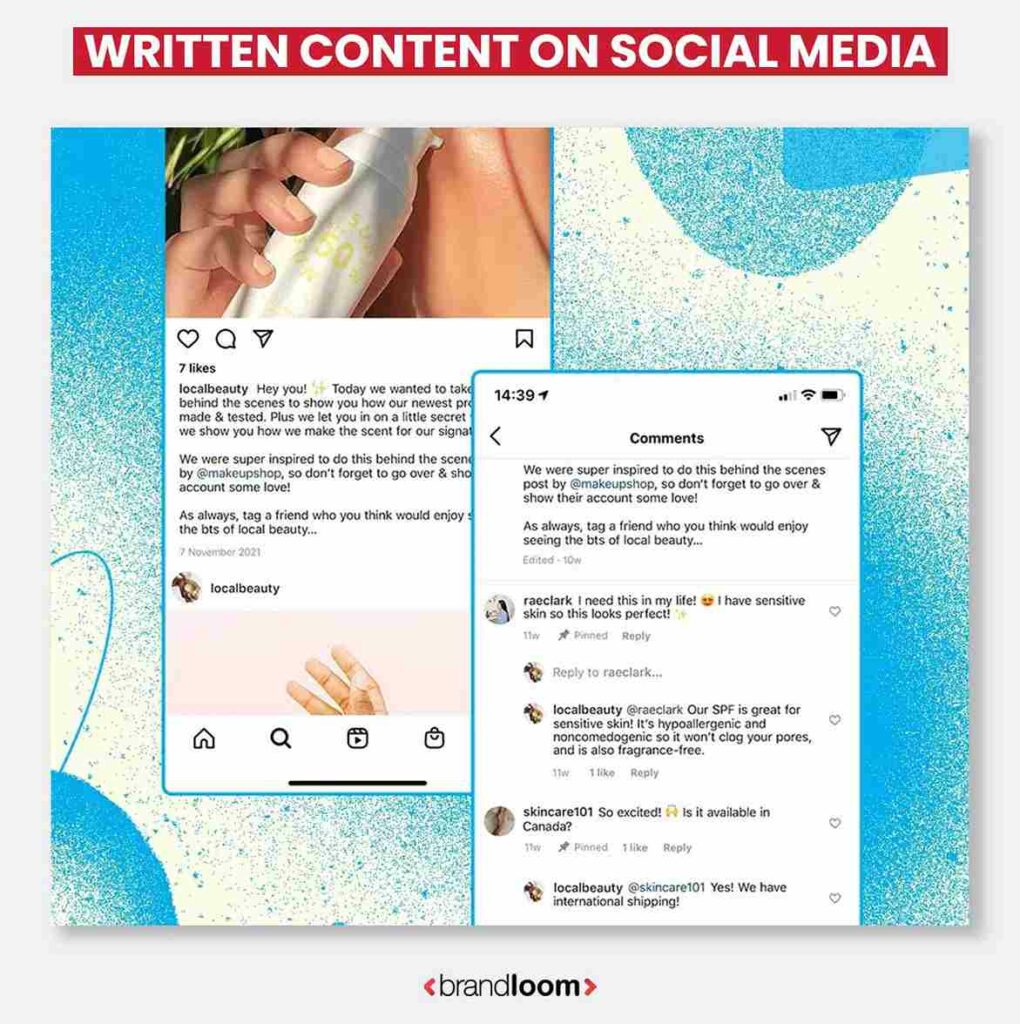
B. Post Pictures
On social media, visual material has huge appeal, with photographs and graphics eliciting significant engagement. Images may represent events, emotions, ideas, companies, news, goods, memes, and more in an instant. Photo postings highlight users’ experiences and sense of self. Users may stylize photographs with simple in-app editing and filters.
Because of the impact and shareability of visuals, picture and graphic postings have become the primary content types associated with sites like Instagram and Pinterest. Photos bring together and excite the highly visual user base of social media.
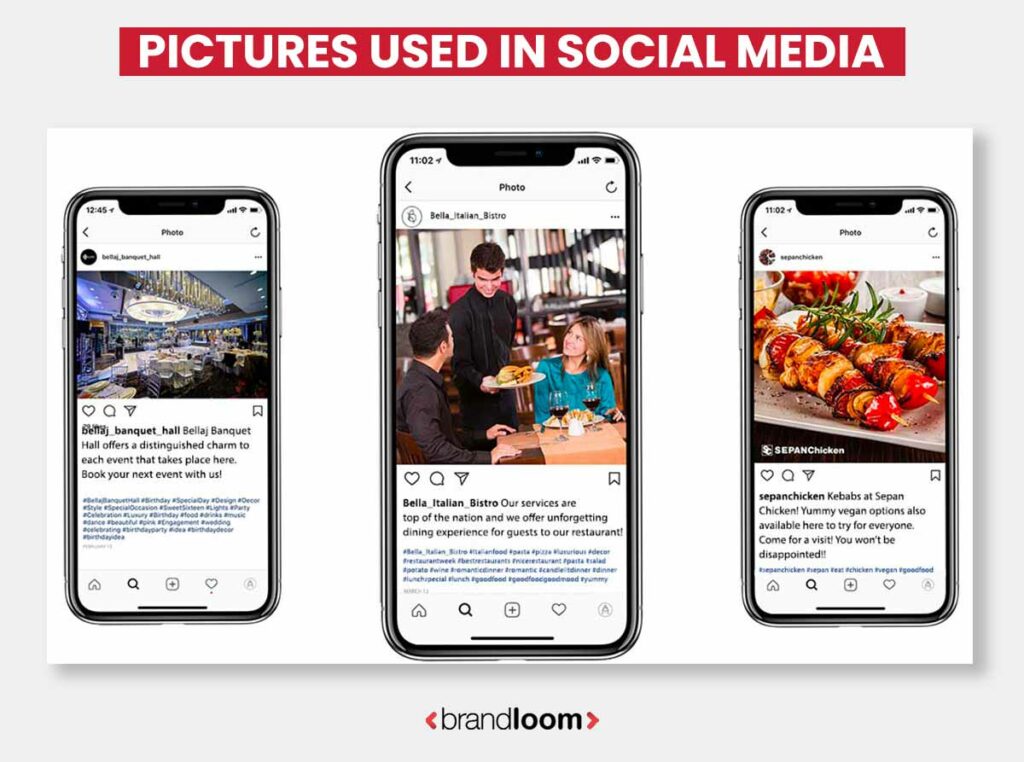
C. Post videos and short clips
Visually and acoustically, videos bring social media to life. They are at the heart of the user experience on platforms like YouTube and TikTok. Through the expressive medium of cinema, short video clips may capture events, highlight abilities, communicate messages, or amuse.
Video is a strong, personable kind of material that is also one of the most engaging for viewers. The visuals, sounds, and capacity to “show, don’t tell” of videos make them instructive and fascinating but longer-than-perfect articles. Overall, video is becoming increasingly popular on social media platforms.
D. Go Live
Live streaming allows producers to send events to followers in real time, allowing people to share their experiences as they develop. Facebook, Instagram, YouTube, Twitch, and Twitter all have built-in streaming features. Broadcasts help consumers feel connected in the present, even if they are far apart.
Commentary and comments from viewers provide an interactive dynamic. While raw and unedited, the live material has a riveting, you-are-there appeal. Streaming offers new opportunities for eyewitness social media, from concerts to conferences, political events, and gaming.
4. Be consistent in branding messaging
Maintaining a consistent brand message is critical for building a solid brand identity and attracting consumers. Companies should ensure that their brand’s visual components, tone, and message are the same on all social media channels. This contributes to developing a unique identity for the brand that resonates with its audience and distinguishes them from competitors.
5. Track and evaluate performance indicators
Tracking and evaluating performance indicators is critical for determining the efficacy of a social media marketing program.
To determine what is effective and what need improvement, businesses should routinely monitor engagement rates, reach, website traffic, and conversion rates.
Businesses may utilize the analytics tools available on social media sites to collect data and modify their approach as necessary.
An effective social media marketing plan requires setting clear goals and objectives, establishing the target audience, creating and spreading useful content, maintaining a consistent brand message, and measuring and assessing performance indicators.
Businesses may develop a marketing plan that engages their audience, increases brand recognition, and produces commercial outcomes by concentrating on five essential elements.
Tips for Effective Social Media Marketing
To be effective in social media marketing, organizations must remain current on the newest trends and best practices. Here are some pointers for successful social media marketing:
1. Recognize Your Audience
Conduct extensive research to develop comprehensive buyer personas that indicate the demographics, interests, values, and pain areas of your following. To acquire customer insights, use surveys, interviews, and social listening.
2. Consistent Branding
Create a consistent brand presence across all social platforms. To develop brand awareness, keep the same logo, color scheme, tone of voice, and visual style. To guarantee consistency, create templated layouts for each platform.
3. Give Visually Appealing Content Priority
Fill your social networks with eye-catching graphics, videos, and photographs tailored to the channel and audience. Because smartphones are the most often used devices, optimize all graphic assets for mobile use.
4. Make Use of Hashtags and Influencers Strategically
Investigate popular and specialized hashtags and participate in relevant discussions. Collaborate with nano and micro-influencers to develop sponsored content and increase your visibility.
If you are looking for an influencer marketing agency, please contact our team.
5. Increase Reach Across Channels
Promote top-performing social material via email, pay-to-boost, website advertisements, and retargeting. Increase reach by using many channels. Investigate integrations to include social media on your website.
6. Analyze metrics regularly and optimize
Analyze platform insights and analytics regularly. Monitor engagement, clicks, conversions, and audience expansion. Based on statistics, continuously adjust your content mix, publishing tempo, and overall approach.
7. Emphasize Relationship Development
Engage in meaningful connections and provide value with your social presence. Respond to inquiries and comments as soon as possible. Share behind-the-scenes material to build a genuine brand community.
Conclusion
Social media marketing presents several challenges, including managing multiple platforms, staying authentic and transparent, maintaining a consistent brand voice, and measuring and analyzing ROI. Businesses may establish a successful strategy that engages their audience, increases brand recognition, and achieves commercial outcomes by recognizing and tackling these problems.
It is a powerful tool for businesses to engage with their audience, build brand awareness, and drive business results. A good strategy targets an audience, sets goals, and creates valuable content. Businesses can boost their online presence, customer engagement, website traffic, and conversion rates.
However, there are several challenges, such as managing multiple platforms, staying authentic and transparent, maintaining a consistent brand voice, and measuring ROI. Businesses must address these challenges to ensure their social media efforts drive results.
Social media marketing is essential for small or large businesses in today’s digital age. Businesses can establish a social media marketing plan that successfully engages their audience and generates company success by keeping up to speed with the latest trends and best practices.
If you want to run social media campaigns but do not know how we at BrandLoom can help you. We offer the best social media marketing strategies in India.
Frequently Asked Questions
1. Is it really so crucial to sell via social media?
Businesses may reach their demographic where they spend the majority of their time by investing in social media marketing. Businesses may benefit from focused advertising and content creation in a number of ways, including increased brand recognition, website traffic, and sales. In addition, social media marketing may help establish rapport with clients and boost loyalty and repeat business.
2. How does social media marketing work?
Social media marketing aims to attract a specific audience by producing and distributing content. This material might be in the form of text, pictures, videos, or even infographics. Companies might employ paid advertising in addition to organic content to expand their customer base and increase sales. Brand recognition, user engagement, and revenue generation are the three primary goals of social media marketing campaigns.
3. Can you explain the advantages of social media advertising?
Increases in visibility, engagement, qualified leads, customer loyalty, and lifetime value are just some of the benefits of social media marketing. Using social media marketing, companies can communicate with consumers right where they hang out online. Businesses may enhance brand visibility and revenue by cultivating customer connections and providing content that appeals to their interests and preferences.
4. What are the most well-liked social media sites for advertising purposes?
Some of the most well-known channels for advertising include social media sites including Facebook, Instagram, Twitter, LinkedIn, YouTube, Pinterest, and Snapchat. There are benefits and drawbacks to using each platform; companies should choose those that are most suited to their intended audience and marketing goals. Instagram, for instance, is a well-liked medium for companies that want to promote visual content and appeal to a younger customer base. To the contrary, B2B firms wishing to network with other professionals and decision-makers will find LinkedIn to be an invaluable resource.
5. How can companies best use social media marketing to communicate their message to consumers?
By catering content to certain demographics and interests, businesses can utilize social media marketing to get their products and services in front of the right people. Take Facebook’s ad targeting capabilities as an example; they allow you to specifically target individuals based on their age, geography, hobbies, and more. Companies may improve the success of their marketing efforts by tailoring their content and advertising to certain demographics.
6. Which social media advertising methods are most often used?
Content calendars, replying to comments and messages, using user-generated material, sponsored advertising efforts, and social media influencers are all common methods of promoting a product or service on social media. These methods help companies reach the clients they spend the most time with on social media, where they may raise brand recognition, boost engagement, and ultimately increase sales.
7. How can companies tell whether their social media marketing is paying off?
Businesses may gauge the performance of their social media marketing campaigns by looking at metrics like engagement, clickthrough, website traffic, leads generated, and sales attributed to social media. Companies may track the success of their marketing initiatives with the use of analytics software like Google Analytics and social media analytics services. Monitoring important indicators and modifying methods as needed is how businesses make sure their social media marketing initiatives get the intended outcomes.
8. In terms of social media promotion, what are some tried-and-true methods?
The best practices include creating a unique voice and style for the company, interacting with fans, and replying to messages and comments. Some examples of best practices for social media strategists include creating high-quality visual material, using targeted advertising, analyzing data to assist decision-making, and keeping up with industry trends and developments. Businesses may boost the success of their marketing by adopting these standards. Better outcomes are within their reach.
9. How do companies begin their use of social media?
To kick off their marketing efforts, businesses should first determine their intended audience, research and choose the most appropriate social media platforms, create a content plan, and then launch their social media accounts. They may develop and disseminate content, interact with their fans, and hone their efforts via statistical analysis. Marketing companies and consultants are another option for businesses seeking assistance.
10. What is social media marketing?
Social media marketing promotes a product, service, or brand through various platforms. This can include creating and sharing content, interacting with followers, running paid advertising campaigns, and leveraging influencers to reach a larger audience.
Connecting with consumers who spend a lot of time – on social media is central to social media marketing goals, including raising brand exposure, generating leads, and increasing sales.
To grow your brand, you must build a solid social media strategy. As such, you should contact India’s best social media marketing agency.

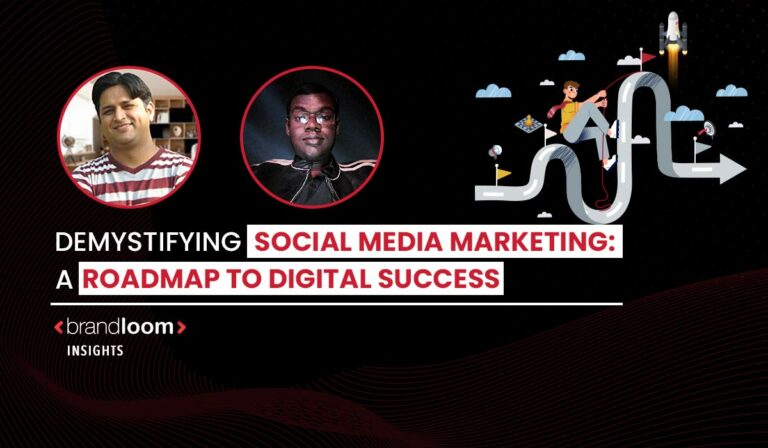


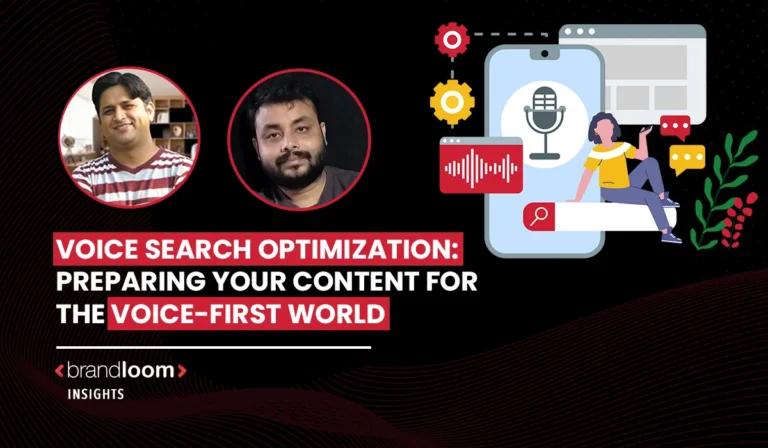


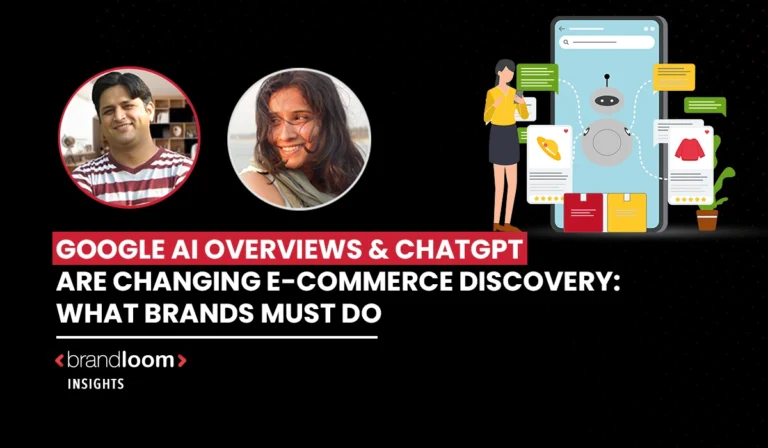
Thank you for your story on Demystifying Social Media Marketing: A Roadmap to Digital Success
Hi Mate, thank you so much. It is so simple and easy to understand. I appreciate that you have shared this knowledge with this blog.